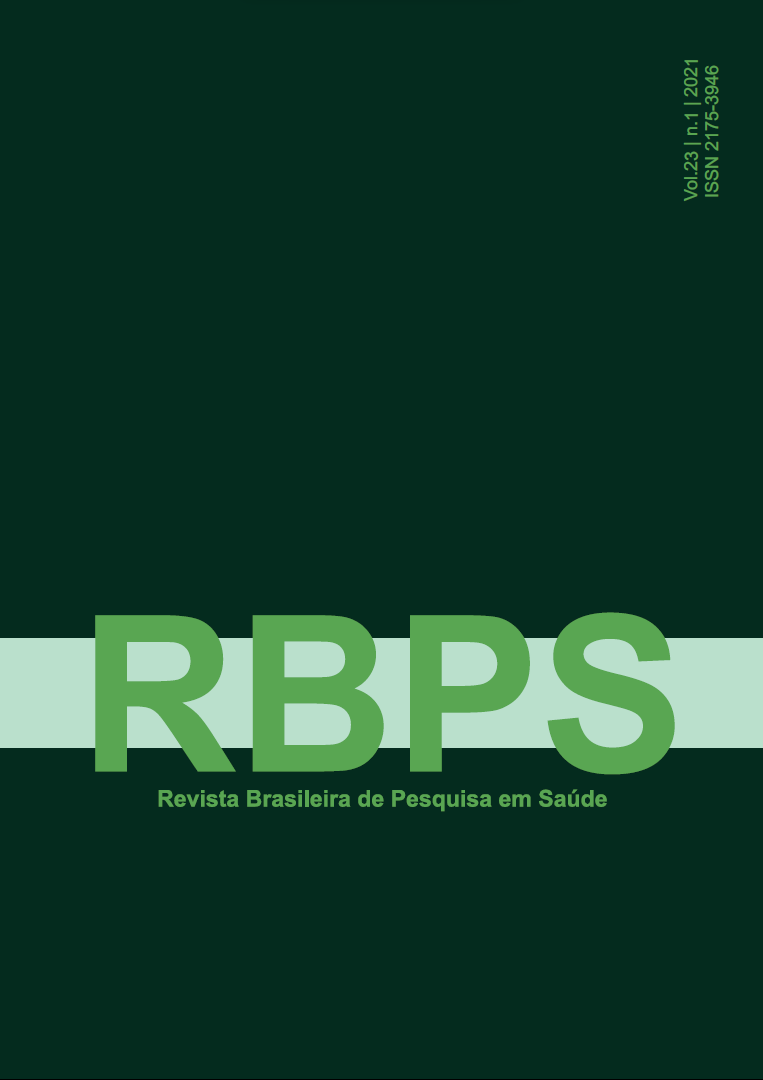Comparison between pathological processes found in virtual and conventional autopsy of two patients who died in a Brazilian university hospital
DOI:
https://doi.org/10.47456/rbps.v23i1.27741Keywords:
Autopsy, Diagnostic Imaging, Tomography X-Ray ComputedAbstract
Introduction:
The practice of conventional autopsy is commonly performed to investigate the death cause in the scientific medical area. However virtual autopsy has a promising alternative in explanation death. Objectives: To compare the anatomopathological findings, the time of execution and the team professionals involved in performing the virtual and conventional autopsies of two patients who died in a university hospital. Methods: Both methods sought to diagnose the cause of death, underlying diseases and pathological processes contributory to the death of two patients. For this, the two patients were first submitted to a virtual autopsy performed by a technician and a radiologist. Then a conventional autopsy was performed by a pathologist and two autopsy technicians. Results: Conventional autopsy identified a higher number of pathological changes in most organs analyzed. However, the virtual autopsy presented shorter execution time, fewer professionals involved and faster conclusion of the report. Conclusion: Although there is a fall in the number of conventional autopsies, this still most appropriate method for the current conditions of the institution where this study was conducted. The appropriate implantation of the virtual autopsy with the joint performance of histological analysis by means of biopsies and angiotomography, proves to be fast and satisfactory alternative in the scientific medical investigation of pathological processes of patients who die in university hospitals.
Downloads
References
2. Moreira DR, Lana AMA. Godoy P. Estudo sobre a autópsia como método diagnóstico. JPBML 2009; 45(3): 239-45.
3. Echenique LS, Mello R de A, Odashiro LN, Nakao L, Franco M. Correlação entre achados macro e microscópicos em 200 autópsias consecutivas: análise custo/benefício do estudo histopatológico completo das autópsias. J Bras Patol Med Lab 2002; 38(3): 219-24.
4. Vogel H. Gewalt im Ro¨ntgenbild Befunde bei Krieg. Folter und Verbrechen Echomed. 1997; 41(1): 13–42.
5. Lundberg GD. Low-tech autopsies in the era of high-tech medicine: continued value for quality assurance and patient safety. JAMA 1998; 280(14): 1273-4.
6. Cottrill HM, O’Connor WN. The autopsy in the 21st century: time for reconsideration. J. Ky Med. Assoc 2000; 98(3): 110-4.
7. Sharija S. Virtopsy-The Most Modern Technique for Postmortem Examination. IJFMT 2013; 7(1): 183-6.
8. Segura MEA, Rocha EM, Lourenço AA, Veloso MGP, Moraes WC. Comparação entre diagnósticos clínicos e os achados de necropsia: análise retrospectiva de 680 pacientes. Bras Patol Med Lab 2006; 42(6): 461-7.
9. Thali MJ, Jackowski C, Oesterhelweg L, Ross SG, Dirnhofer R. Virtopsy – the swiss virtual autopsy approach. Leg Med 2007; 9(2): 100-4.
10. Cavallari EL, Picka MCM, Picka MCM. O uso da Tomografia Computadorizada e da Ressonância Magnética na Virtópsia. Tekhne e Logos 2017; 8(1): 93-102.
11. Steigman CK. The autopsy as a quality assurance tool: last rites or resurrection?. Arch Pathol Lab Med 1996; 34(5): 736-8.
12. Thali MJ, Yen K, Schweitzer W, Vock P, Boesch C, Ozdoba C, et al. Virtopsy, a New Imaging Horizon in Forensic Pathology: Virtual Autopsy by Postmortem Multislice Computed Tomography (MSCT) and Magnetic Resonance Imaging (MRI) a Feasibility Study. J Forensic Sci 2003; 48(2): 386-403.
13. Polacco M, D’Allseio P, Ausania F, Zobel B, Pascali VL, d’Aloja E, et al. Virtual Autopsy in Hanging. Am J Forensic Med Pathol 2013; 34(2): 107-9.
14. Ampanozi G, Hatch GM, Flach PM, Thali MJ, Ruder TD. Postmortem magnetic resonace imaging: Reproducing typical autopsy heart measurements. Legal Medicine 2015; 17(6): 493-8.
15. Santos MLO. Padrão em vidro fosco nas doenças pulmonares difusas. Correlação da tomografia computadorizada de alta resolução com a anatomopatologia. Rad Bras 2002; 35(3): 170.
16. Urbania TH, Hope MD, Huffaker SD, Reddy GP. Role of computed tomography in the evaluation of acute chest pain. J Cardiovasc Comput Tomogr 2009; 3(1 Suppl): S13–22.
17. Schertler T, Frauenfelder T, Stolzmann P, Scheffel H, Desbiolles L, Marincek B, et al. Triple rule-out CT in patients with suspicion of acute pulmonary embolism: findings and accuracy. Acad Radiol 2009; 16(6): 708–17.
18. Janne d’Othée B, Siebert U, Cury R, Jadvar H, Dunn EJ, Hoffmann. A systematic review on diagnostic accuracy of CT-based detection of significant coronary artery disease. Eur J Radiol 2008; 65(3): 449–61.
19. Ross SG, Bolliger SA, Ampanozi G, Oesterhelweg L, Thali MJ, Flach PM. Postmortem CT Angiography: Capabilities and Limitations in Traumatic and Natural Causes of Death. Radiographics 2014; 34(4): 830-46.
20. Pazeres CEE, Cury RC, Carneiro AC de Castro, Rochitte CE. Angiotomografia de coronárias na avaliação da dor torácica aguda na sala de emergência. Arq Bras Cardiol 2013; 101(6): 562-9.
21. Stadler A, Schima W, Ba-Ssalamah A, Kettenbach J, Eisenhuber E. Artifacts in Body MR Imaging: their appearance and how to eliminate them. Eur Radiol 2007; 17(5): 1242-55.
22. Santiago RC, Vitral RWF. Métodos de avaliação da densitometria óssea e seu emprego na odontologia. Pesq Bras Odontoped Clin Integr 2006; 6(3): 289-94.
23. Tejaswi KB, Periya EAH. Virtopsy (virtual autopsy): A new phase in forensic investigation. J Forensic Dent Sci 2013; 5(2): 146-8.
Downloads
Published
How to Cite
Issue
Section
License
Copyright (c) 2021 Revista Brasileira de Pesquisa em Saúde/Brazilian Journal of Health Research

This work is licensed under a Creative Commons Attribution-NonCommercial-NoDerivatives 4.0 International License.
Authors and reviewers must disclose any financial, professional, or personal conflicts of interest that could influence the results or interpretations of the work. This information will be treated confidentially and disclosed only as necessary to ensure transparency and impartiality in the publication process.
Copyright
RBPS adheres to the CC-BY-NC 4.0 license, meaning authors retain copyright of their work submitted to the journal.
- Originality Declaration: Authors must declare that their submission is original, has not been previously published, and is not under review elsewhere.
- Publication Rights: Upon submission, authors grant RBPS the exclusive right of first publication, subject to peer review.
- Additional Agreements: Authors may enter into non-exclusive agreements for the distribution of the RBPS-published version (e.g., in institutional repositories or as book chapters), provided the original authorship and publication by RBPS are acknowledged.
Authors are encouraged to share their work online (e.g., institutional repositories or personal websites) after initial publication in RBPS, with appropriate citation of authorship and original publication.
Under the CC-BY-NC 4.0 license, readers have the rights to:
- Share: Copy and redistribute the material in any medium or format.
- Adapt: Remix, transform, and build upon the material.
These rights cannot be revoked, provided the following terms are met:
- Attribution: Proper credit must be given, a link to the license provided, and any changes clearly indicated.
- Non-Commercial: The material cannot be used for commercial purposes.
- No Additional Restrictions: No legal or technological measures may be applied to restrict others from doing anything the license permits.

























